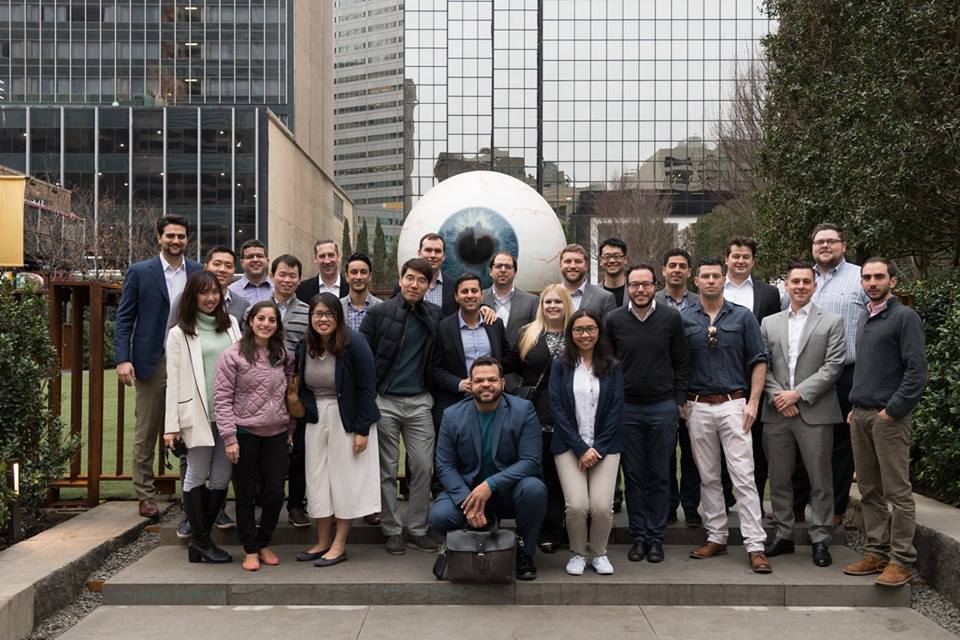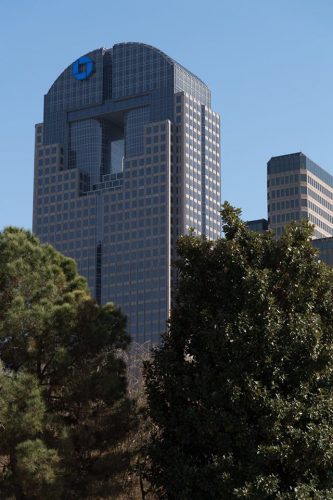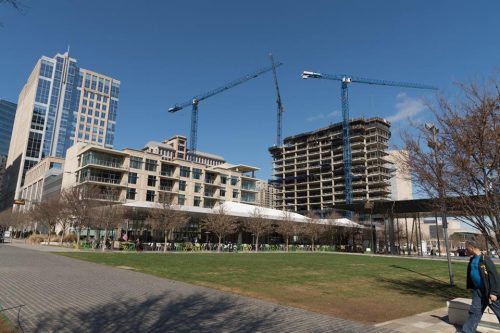 From January 18-21, 2017, the Baker Program in Real Estate Class of 2018 visited Dallas, Texas to participate in their domestic inter-session trek. Their first full day in Dallas began with a brief morning walk through downtown towards Mercantile Place. On the way, the students passed the iconic Dallas eyeball; it would be interesting to study the impact that the art piece has had on property values since its installation in 2013. They also passed the original Neiman Marcus – Texas-based luxury department store – in downtown Dallas. The class was later informed that the decision made by Neiman Marcus to maintain its original location, despite the area falling into disrepair, was a key factor in salvaging downtown with revitalization efforts.
From January 18-21, 2017, the Baker Program in Real Estate Class of 2018 visited Dallas, Texas to participate in their domestic inter-session trek. Their first full day in Dallas began with a brief morning walk through downtown towards Mercantile Place. On the way, the students passed the iconic Dallas eyeball; it would be interesting to study the impact that the art piece has had on property values since its installation in 2013. They also passed the original Neiman Marcus – Texas-based luxury department store – in downtown Dallas. The class was later informed that the decision made by Neiman Marcus to maintain its original location, despite the area falling into disrepair, was a key factor in salvaging downtown with revitalization efforts.
Mercantile Place is a collection of four communities containing a combined 700 apartment units, located on Main Street between the Neiman Marcus flagship store and the new Main Street Park. “Mercantile Place is serving as a catalyst for new growth and development in the city.” The project exemplifies the effort that the City of Dallas made, working with private developers, to revitalize its downtown. The structures were built in the mid-twentieth century as office towers, but were recently converted to apartment units by Forest City Texas, Inc. Upon arriving at the site, the Baker class met with Karl Stundins from the Economic Development Department of the City of Dallas and with Jim Truitt, Executive Vice President of Forest City Texas, Inc. Meeting Karl and Jim together and hearing about their working relationship, which both see in an overwhelmingly positive light, was a true testament to the level of collaboration between the public and private sectors to effect change in downtown Dallas.
 As only one Baker Program Class of 2018 student is from Texas, Karl and Jim shared some insight into how the downtown Dallas area had evolved over the past number of years. About two decades before the City of Dallas stepped in, downtown Dallas experienced a transition from being the center of commerce to becoming largely vacant. Many businesses, employers, and retailers began shifting towards the trendier Uptown neighborhood as downtown became less compelling. With the area falling into decay, the City of Dallas decided to intervene. The Economic Development Department of the City of Dallas make the strategic decision to collaborate with the private sector to undertake this challenge. The City elected to work with Forest City Texas Inc., given Forest City’s experience and track record working with public sector bodies and municipalities on public-private partnerships.
As only one Baker Program Class of 2018 student is from Texas, Karl and Jim shared some insight into how the downtown Dallas area had evolved over the past number of years. About two decades before the City of Dallas stepped in, downtown Dallas experienced a transition from being the center of commerce to becoming largely vacant. Many businesses, employers, and retailers began shifting towards the trendier Uptown neighborhood as downtown became less compelling. With the area falling into decay, the City of Dallas decided to intervene. The Economic Development Department of the City of Dallas make the strategic decision to collaborate with the private sector to undertake this challenge. The City elected to work with Forest City Texas Inc., given Forest City’s experience and track record working with public sector bodies and municipalities on public-private partnerships.
Together, the City of Dallas and Forest City Texas Inc. assessed the situation and determined that approximately 24,000 residential units could be absorbed in downtown. By shifting towards multifamily and away from office, the city and Forest City Texas Inc. had the opportunity to attract a different type of life and activity in the area. The needs of this new tenant base differ significantly from the office tenants who occupied the space previously. Karl and Jim noted that they had to think carefully about how to design streetscapes and place parks and retail spaces to attract new residential tenants. In addition, the city began to place a new mass transit system downtown to connect the residents to other areas of Dallas.
The redevelopment of downtown Dallas was largely not market driven. The City of Dallas had to therefore support private sector developers with financial incentives. The city utilized tax increment financing (TIF) to support these revitalization efforts. An original TIF district was put into place in 1996, but by 2005 only 50% of the space supported by the TIF had been redeveloped. Dallas created a second TIF district, taking advantage of the ability to create non-continuous TIF areas. The city found success by creating a TIF district in Uptown to fund development in Downtown. The efforts made by the City of Dallas and Forest City Texas Inc. were a resounding success. The city was able to shift from having 300 apartments downtown to over 10,000, with 30,000 units area-wide.
 Our next stop was to the Sheraton Dallas, where we met with General Manager Mark Sanders. With 1840 guest rooms, this hotel is the largest Sheraton in North America; its stellar performance in 2016 – setting historical records – is a true testament to the growth that Dallas is experiencing. The Baker students learnt that Dallas is one of the most accessible major cities in America. It is about a 3 hour flight from most major centers, and is therefore selected to host many corporate offices and retreats. Dallas’ corporate growth translates to higher RevPAR and occupancy levels in the hospitality sector, and the Sheraton Dallas is no exception. The Sheraton also benefits from direct mass transit access and from easy accessibility to Dallas’ two major airports: DFW and Love Field. The hotel has an agreement with Southwest Airlines that allows hotel operations to distribute staff and operating expenses more evenly between peak periods. Although the property has many advantages from a revenue perspective, maintenance and capital costs can quickly escalate due to the scale of the hotel. To give a sense of scale, Mark noted that the hotel has 54 elevators, more than any building in Dallas except the DFW airport, 10,000 pillows, and 11,000 conference chairs.
Our next stop was to the Sheraton Dallas, where we met with General Manager Mark Sanders. With 1840 guest rooms, this hotel is the largest Sheraton in North America; its stellar performance in 2016 – setting historical records – is a true testament to the growth that Dallas is experiencing. The Baker students learnt that Dallas is one of the most accessible major cities in America. It is about a 3 hour flight from most major centers, and is therefore selected to host many corporate offices and retreats. Dallas’ corporate growth translates to higher RevPAR and occupancy levels in the hospitality sector, and the Sheraton Dallas is no exception. The Sheraton also benefits from direct mass transit access and from easy accessibility to Dallas’ two major airports: DFW and Love Field. The hotel has an agreement with Southwest Airlines that allows hotel operations to distribute staff and operating expenses more evenly between peak periods. Although the property has many advantages from a revenue perspective, maintenance and capital costs can quickly escalate due to the scale of the hotel. To give a sense of scale, Mark noted that the hotel has 54 elevators, more than any building in Dallas except the DFW airport, 10,000 pillows, and 11,000 conference chairs.
